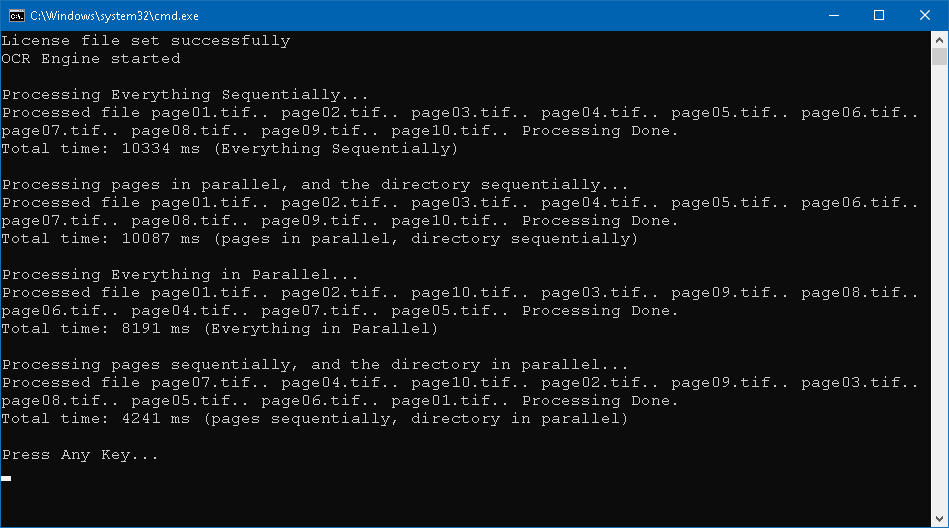Multi-thread OCR with the Auto Recognize Manager - C# .NET 6
This tutorial shows how to multi-thread the OCR engine for parallel processing in a C# .NET 6 application using the LEADTOOLS SDK.
| Overview | |
|---|---|
| Summary | This tutorial covers how to multi-thread the OCR Engine using the IOcrAutoRecognizeManager in a C# .NET 6 Console application. |
| Completion Time | 20 minutes |
| Visual Studio Project | Download tutorial project (1 KB) |
| Platform | C# .NET 6 Console Application |
| IDE | Visual Studio 2022 |
| Runtime Target | .NET 6 or higher |
| Development License | Download LEADTOOLS |
| Try it in another language |
|
Required Knowledge
Get familiar with the basic steps of creating a project by reviewing the Add References and Set a License tutorial, before working on this tutorial.
Create the Project and Add LEADTOOLS References
Start with a copy of the project created in the Add References and Set a License tutorial. If you do not have that project, follow the steps in that tutorial to create it.
The references needed depend upon the purpose of the project. References can be added by one or the other of the following two methods (but not both).
If using NuGet references, this tutorial requires the following NuGet package:
Leadtools.Ocr
If using local DLL references, the following DLLs are needed.
The DLLs are located at <INSTALL_DIR>\LEADTOOLS23\Bin\net:
Leadtools.Codecs.dllLeadtools.Core.dllLeadtools.dllLeadtools.Document.Writer.dllLeadtools.Ocr.LEADEngine.dllLeadtools.Ocr.dll
For a complete list of which DLL files are required for your application, refer to Files to be Included With Your Application.
Set the License File
The License unlocks the features needed for the project. It must be set before any toolkit function is called. For details including tutorials for different platforms, refer to Setting a Runtime License.
There are two types of runtime licenses:
- Evaluation license, obtained at the time the evaluation toolkit is downloaded. It allows the toolkit to be evaluated.
- Deployment license. If a Deployment license file and developer key are needed, refer to Obtaining a License.
Add the Multi-threading OCR Code
With the project created, the references added, and the license set, coding can begin.
In Solution Explorer, open Program.cs. Add the following statements to the using block at the top of Program.cs:
using Leadtools;using Leadtools.Ocr;using Leadtools.Document.Writer;using System.Diagnostics;
The IOcrAutoRecognizeManager interface supports using multiple threads when processing a job. The number of threads can be controlled using the MaximumThreadsPerJob property.
It is also possible to execute each job in its own thread, which is done in the code below using Parallel.ForEach.
Add a new method to the Program class, named OCR(). Call the new method inside the Main() method, below the call to InitLEAD. Add the code below to the OCR() method to test four different combinations of sequential and parallel processing.
static void OCR(){using IOcrEngine ocrEngine = OcrEngineManager.CreateEngine(OcrEngineType.LEAD);string inputDirectory = @"FILE PATH TO INPUT DIRECTORY";string outputDirectory = @"FILE PATH TO OUTPUT DIRECTORY";Stopwatch stopwatch = new Stopwatch();ocrEngine.Startup(null, null, null, @"C:\LEADTOOLS23\Bin\Common\OcrLEADRuntime");Console.WriteLine("OCR Engine started");Console.WriteLine();IOcrAutoRecognizeManager manager = ocrEngine.AutoRecognizeManager;var files = Directory.EnumerateFiles(inputDirectory, "*.tif");manager.MaximumThreadsPerJob = 1; //1 thread per jobConsole.WriteLine("Processing Everything Sequentially...");stopwatch.Reset();stopwatch.Start();Console.Write($"Processed file ");foreach (var file in files){Guid id = Guid.NewGuid(); //Create new file namemanager.Run(file, outputDirectory + id.ToString() + ".pdf", DocumentFormat.Pdf, null, null);Console.Write($"{Path.GetFileName(file)}.. ");}stopwatch.Stop();Console.WriteLine("Processing Done.");Console.WriteLine($"Total time: {stopwatch.ElapsedMilliseconds} ms (Everything Sequentially)");Console.WriteLine();// Set to use Maximum CPU's/Cores of current machine.manager.MaximumThreadsPerJob = 0;Console.WriteLine("Processing pages in parallel, and the directory sequentially...");stopwatch.Reset();stopwatch.Start();Console.Write($"Processed file ");foreach (var file in files){Guid id = Guid.NewGuid(); //Create new file namemanager.Run(file, outputDirectory + id.ToString() + ".pdf", DocumentFormat.Pdf, null, null);Console.Write($"{Path.GetFileName(file)}.. ");}stopwatch.Stop();Console.WriteLine("Processing Done.");Console.WriteLine($"Total time: {stopwatch.ElapsedMilliseconds} ms (pages in parallel, directory sequentially)");Console.WriteLine();Console.WriteLine("Processing Everything in Parallel...");stopwatch.Reset();stopwatch.Start();Console.Write($"Processed file ");Parallel.ForEach(files, (file) =>{Guid id = Guid.NewGuid(); //Create new file namemanager.Run(file, outputDirectory + id.ToString() + ".pdf", DocumentFormat.Pdf, null, null);Console.Write($"{Path.GetFileName(file)}.. ");});stopwatch.Stop();Console.WriteLine("Processing Done.");Console.WriteLine($"Total time: {stopwatch.ElapsedMilliseconds} ms (Everything in Parallel)");Console.WriteLine();manager.MaximumThreadsPerJob = 1; //1 thread per jobConsole.WriteLine("Processing pages sequentially, and the directory in parallel...");stopwatch.Reset();stopwatch.Start();Console.Write($"Processed file ");Parallel.ForEach(files, (file) =>{Guid id = Guid.NewGuid(); //Create new file namemanager.Run(file, outputDirectory + id.ToString() + ".pdf", DocumentFormat.Pdf, null, null);Console.Write($"{Path.GetFileName(file)}.. ");});stopwatch.Stop();Console.WriteLine("Processing Done.");Console.WriteLine($"Total time: {stopwatch.ElapsedMilliseconds} ms (pages sequentially, directory in parallel)");Console.WriteLine();Console.WriteLine("Press Any Key...");Console.ReadKey();}
Note: Make sure to set appropriate folder names in the
inputDirectoryandoutputDirectoryvariables. The input directory must contain TIFF files(*.tif)to be processed by the application created in this tutorial.
Run the Project
Run the project by pressing F5, or by selecting Debug -> Start Debugging.
If the steps were followed correctly, the console appears and the application converts the TIFF images to PDF format and saves them to the specified location. This is repeated four times using different combinations of sequential and parallel processing.

Important Note
In the test shown by the image, the best results were obtained when processing pages sequentially and the directory in parallel. However, this is not always the case, and a different combination could produce better results with a different set of images or when using a different computer with a different number of CPU cores. Therefore, it is important to test with actual images that represent the use case, on the actual hardware where the application will be used.
Wrap-up
This tutorial showed how to create a console-based OCR application that uses the LEAD OCR Engine to compare the performance when using different techniques of sequential and parallel processing.
